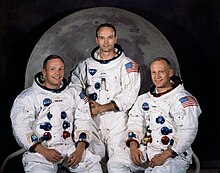
Back Apollo 11 Afrikaans አፖሎ ፲፩ Amharic Apollo 11 AN أبولو 11 Arabic এপ'ল' ১১ Assamese Apollo 11 AST Apollon 11 Azerbaijani آپولو 11 AZB Apollo 11 BAN Апалон-11 Byelorussian
 Buzz Aldrin poses on the Moon, allowing Neil Armstrong to photograph both of them using the visor's reflection. | |
| Mission type | Crewed lunar landing |
|---|---|
| Operator | NASA |
| COSPAR ID |
|
| SATCAT no. |
|
| Mission duration | 8 days, 3 hours, 18 minutes, 35 seconds |
| Spacecraft properties | |
| Spacecraft |
|
| Manufacturer |
|
| Launch mass | 100,756 pounds (45,702 kg) |
| Landing mass | 10,873 pounds (4,932 kg) |
| Crew | |
| Crew size | 3 |
| Members | |
| Callsign |
|
| Start of mission | |
| Launch date | July 16, 1969, 13:32:00 UTC |
| Rocket | Saturn V SA-506 |
| Launch site | Kennedy Space Center LC-39A |
| End of mission | |
| Recovered by | USS Hornet |
| Landing date | July 24, 1969, 16:50:35 UTC |
| Landing site | North Pacific Ocean 13°19′N 169°9′W / 13.317°N 169.150°W |
| Orbital parameters | |
| Reference system | Selenocentric |
| Pericynthion | 100.9 kilometers (54.5 nmi)[1] |
| Apocynthion | 122.4 kilometers (66.1 nmi)[1] |
| Inclination | 1.25 degrees[1] |
| Period | 2 hours[1] |
| Epoch | July 19, 1969, 21:44 UTC[1] |
| Lunar orbiter | |
| Spacecraft component | Command and service module |
| Orbital insertion | July 19, 1969, 17:21:50 UTC[2] |
| Orbital departure | July 22, 1969, 04:55:42 UTC[3] |
| Orbits | 30 |
| Lunar lander | |
| Spacecraft component | Apollo Lunar Module |
| Landing date | July 20, 1969, 20:17:40 UTC |
| Return launch | July 21, 1969, 17:54 UTC |
| Landing site | Mare Tranquillitatis Template:Lunar coords and quad cat[4] |
| Sample mass | 21.55 kilograms (47.51 lb) |
| Surface EVAs | 1 |
| EVA duration | 2 hours, 31 minutes, 40 seconds |
| Docking with LM | |
| Docking date | July 16, 1969, 16:56:03 UTC[2] |
| Undocking date | July 20, 1969, 17:44:00 UTC[5] |
| Docking with LM ascent stage | |
| Docking date | July 21, 1969, 21:35:00 UTC[3] |
| Undocking date | July 21, 1969, 23:41:31 UTC[3] |

 Left to right: Neil Armstrong, Michael Collins, Buzz Aldrin | |
Apollo 11 was the first flight to send people to the moon. It was done by NASA, the American space group. It went up to space on July 16, 1969, carrying three astronauts: Neil Armstrong, Buzz Aldrin and Michael Collins. On July 20, 1969, Armstrong and Aldrin became the first humans to land on the moon, while Collins stayed in orbit around the Moon.
The flight was part of the Space Race. It finished the plan set by John F. Kennedy in 1961 to "land a man on the moon, and return him safely to the Earth", before the 1960s ended.
- ↑ 1.0 1.1 1.2 1.3 1.4 "Apollo 11 Mission Summary". The Apollo Program. National Air and Space Museum. Archived from the original on August 29, 2013. Retrieved September 7, 2013.
- ↑ 2.0 2.1 Orloff 2000, p. 106.
- ↑ 3.0 3.1 3.2 Orloff 2000, p. 109.
- ↑ Williams, David R. (December 11, 2003). "Apollo Landing Site Coordinates". NASA Space Science Data Coordinated Archive. NASA. Retrieved September 7, 2013.
- ↑ Orloff 2000, p. 107.